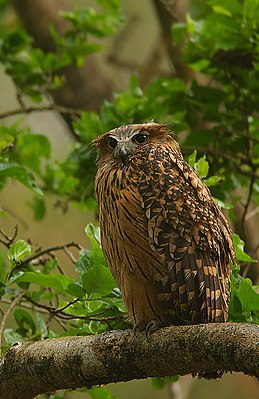Himalayan fish owl
| Himalayan fish owl | ||||||||||
|---|---|---|---|---|---|---|---|---|---|---|

Himalayan Fischuhu ( Ketupa flavipes ) |
||||||||||
| Systematics | ||||||||||
|
||||||||||
| Scientific name | ||||||||||
| Ketupa flavipes | ||||||||||
| ( Hodgson , 1836) |
The Himalayan fish owl ( Ketupa flavipes ) is a species from the family of real owls. It occurs exclusively in Southeast Asia.
features
The animals have a body length of 48 to 58 centimeters. On the upper side of the body, Himalayan Fischuhus are reddish-brown to reddish. The upper plumage also has broad, dark longitudinal stripes. The scapulars are pale ocher and form a noticeable pale line in the shoulder region. The wings and tail are dark brown with cream stripes. The eyebrows, forehead and throat are whitish. The spring ears are oriented horizontally rather than vertically. The legs are relatively long and feathered in the upper third.
Can be confused with the Sunda Fischuhu. However, this is overall browner.
distribution and habitat
The Himalayan Fischuhu occurs from the Himalayas in northern India to Nepal, Bhutan and Assam as well as the northeast of Bangladesh. It also colonizes southeast and central China and Taiwan. Its distribution area extends from there to the north of Burma and Laos as well as Vietnam. It is a resident bird that prefers to live in forests. It occurs at altitudes of up to 1,500 m in Nepal and up to 2,450 m in northern India.
Way of life
Of all fish owls , the Himalayan fish owl is the strongest. It is most active at dusk, but also often hunts during the day when it is raising young. He prefers to hunt along streams. Accordingly, its food spectrum consists largely of fish, crabs and frogs. He also frequently hunts bamboo rats . However, due to his physical strength, he is also able to beat pheasants.
Relatively little is known about its breeding biology. In India it breeds from November to February. In Assam it breeds mainly in the period December to February. The clutch usually consists of two eggs.
supporting documents
Single receipts
literature
- Claus König , Friedhelm Weick: Owls of the World . Christopher Helm, London 2008, ISBN 978-0-7136-6548-2
Web links
- Ketupa flavipes inthe IUCN 2013 Red List of Threatened Species . Listed by: BirdLife International, 2012. Retrieved February 6, 2014.